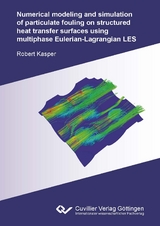Numerical modeling and simulation of particulate fouling on structured heat transfer surfaces using multiphase Eulerian-Lagrangian LES
Seiten
2021
Cuvillier Verlag
978-3-7369-7419-7 (ISBN)
Cuvillier Verlag
978-3-7369-7419-7 (ISBN)
Durch die gezielte Strukturierung von wärmeübertragenden Oberflächen, wie beispielsweise durch Dellen oder Rippen, kann die örtliche Turbulenz und damit die thermische Durchmischung gesteigert werden. Dies kann die Effizienz von Wärmeübertragern oder Bauteilkühlsystemen erheblich erhöhen. Derartige Oberflächenstrukturrierungen begünstigen jedoch das Partikelfouling, daher die Ablagerung suspendierter Partikel, wie z.B. Sand, Schlamm oder Korrosionsprodukte.
Gegenstand dieser Arbeit ist die Entwicklung eines universellen, numerischen CFD-Verfahrens zur Vorhersage des partikulären Foulings auf strukturierten Oberflächen, speziell Dellenoberflächen. Das entwickelte Verfahren basiert auf einer Kombination des Lagrangian-Particle-Trackings zur Beschreibung der dispersen Phase (Foulingpartikel), sowie räumlich und zeitlich aufgelöster Large-Eddy Simulation für die Berechnung der kontinuierlichen Phasen (Trägerfluid). Dieses Vorgehen ermöglicht nicht nur die Auswertung der infolge der Partikelablagerungen verminderten thermo-hydraulischen Effizienz, sondern auch die Untersuchung der Wechselwirkungen zwischen turbulenten Strömungsstrukturen und dem partikulärem Fouling. Dadurch kann gezeigt werden, dass die Verwendung von sphärischen Dellen als Oberflächenstrukturen nicht nur aus thermo-hydraulischer Sicht die optimale Wahl darstellt, sondern auch eine substantielle Verminderung des Partikelfoulings begünstigt. The application of structured heat transfer surfaces, such as dimples or ribs, increase the local turbulence and thus thermal mixing. This can improve the efficiency of heat exchangers or cooling systems significantly. However, structured surfaces are known to promote particulate fouling, hence the unwanted accumulation and deposition of suspended particles (e.g., silt, sludge or iron oxide).
The scope of this work is the development of a universal numerical CFD method for the prediction of particulate fouling, especially on dimpled surfaces. The proposed approach is based on a combination of the Lagrangian point-particle tracking for the description of the disperse phase (fouling particles), and spatially and temporally resolved large-eddy simulations for the calculation of the continuous phase (carrier fluid). This approach allows not only the evaluation of the reduced thermo-hydraulic efficiency due to particle deposition, but also the investigation of the interaction between turbulent flow structures and the particulate fouling. It can be shown that the usage of spherical dimples as surface structures is not only the optimal choice from a thermo-hydraulic point of view, but also favors a substantial reduction of particulate fouling.
Gegenstand dieser Arbeit ist die Entwicklung eines universellen, numerischen CFD-Verfahrens zur Vorhersage des partikulären Foulings auf strukturierten Oberflächen, speziell Dellenoberflächen. Das entwickelte Verfahren basiert auf einer Kombination des Lagrangian-Particle-Trackings zur Beschreibung der dispersen Phase (Foulingpartikel), sowie räumlich und zeitlich aufgelöster Large-Eddy Simulation für die Berechnung der kontinuierlichen Phasen (Trägerfluid). Dieses Vorgehen ermöglicht nicht nur die Auswertung der infolge der Partikelablagerungen verminderten thermo-hydraulischen Effizienz, sondern auch die Untersuchung der Wechselwirkungen zwischen turbulenten Strömungsstrukturen und dem partikulärem Fouling. Dadurch kann gezeigt werden, dass die Verwendung von sphärischen Dellen als Oberflächenstrukturen nicht nur aus thermo-hydraulischer Sicht die optimale Wahl darstellt, sondern auch eine substantielle Verminderung des Partikelfoulings begünstigt. The application of structured heat transfer surfaces, such as dimples or ribs, increase the local turbulence and thus thermal mixing. This can improve the efficiency of heat exchangers or cooling systems significantly. However, structured surfaces are known to promote particulate fouling, hence the unwanted accumulation and deposition of suspended particles (e.g., silt, sludge or iron oxide).
The scope of this work is the development of a universal numerical CFD method for the prediction of particulate fouling, especially on dimpled surfaces. The proposed approach is based on a combination of the Lagrangian point-particle tracking for the description of the disperse phase (fouling particles), and spatially and temporally resolved large-eddy simulations for the calculation of the continuous phase (carrier fluid). This approach allows not only the evaluation of the reduced thermo-hydraulic efficiency due to particle deposition, but also the investigation of the interaction between turbulent flow structures and the particulate fouling. It can be shown that the usage of spherical dimples as surface structures is not only the optimal choice from a thermo-hydraulic point of view, but also favors a substantial reduction of particulate fouling.
| Erscheinungsdatum | 04.05.2021 |
|---|---|
| Verlagsort | Göttingen |
| Sprache | englisch |
| Maße | 148 x 210 mm |
| Themenwelt | Naturwissenschaften ► Physik / Astronomie ► Thermodynamik |
| Technik ► Maschinenbau | |
| Schlagworte | Ablagerungsbildung • body force vector • cartesian coordinates • cell value • Channel flows • Cross stress tensor • Dehnungsgeschwindigkeitstensor • Dellen • Deposit formation • dimples • dispersed multiphase flows • disperse Mehrphasenströmungen • drag coefficient • Druckverlust • Eulerian-Lagrangian • Euler-Lagrange • fanning friction factor • Fanning-Reibungsfaktor • Filterkern • Filter kernel • Fouling • fouling mitigation • fouling resistance • Foulingverminderung • Gesamtwärmeübergangskoeffizient • Grobstruktursimulation • heat transfer • heat transfer augmentation • Identitätstensor • Identity tensor • Impulsive force • Impulskraft • Kanalströmungen • kartesische Koordinaten • kinetic energy • Kinetische Energie • Kolmogorov constant • Kolmogorow-Konstante • Körperkraftvektor • Kreuzspannungstensor • Large Eddy Simulation • Multiscale simulations • Multiskalensimulationen • Overall heat transfer coefficient • particle-laden flows • Partikelbeladene Strömungen • Partikelfouling • pressure loss • Raumvektor • Schleppkoeffizient • Smagorinsky constant • Smagorinsky-Konstante • space vector • stagnation point • Stagnationspunkt • Strain rate tensor • Streckspannung • structured heat transfer surfaces • strukurierte wärmeübertragende Oberflächen • Thermal Diffusivity • thermischer Widerstand • thermo-hydraulic efficiency • thermo-hydraulische Effizienz • Turbulence • Turbulence production rate • Turbulence stress tensor • turbulente Strömungen • turbulent flows • Turbulenz • Turbulenzproduktionsrate • Turbulenzspannungstensor • Verschmutzungswiderstand • Vortex Structures • Wärmedurchlässigkeit • Wärmeübergang • Wärmeübergangserhöhung • Wirbelstrukuren • Yield Stress • Zellenwert |
| ISBN-10 | 3-7369-7419-1 / 3736974191 |
| ISBN-13 | 978-3-7369-7419-7 / 9783736974197 |
| Zustand | Neuware |
| Haben Sie eine Frage zum Produkt? |
Mehr entdecken
aus dem Bereich
aus dem Bereich
Hauptsätze, Prozesse, Wärmeübertragung
Buch | Softcover (2023)
De Gruyter Oldenbourg (Verlag)
CHF 62,90




